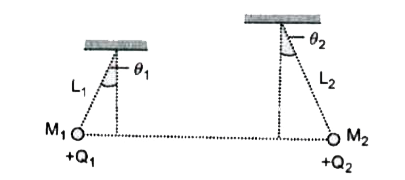When a metallic surface is illuminated by light of frequency a photoelectron of energy 0.5eV is emitted. When the same surface is illuminated by light of frequency photoelectron of maximum energy 2 eV is emitted. The work function is :Solution in Kannada
0.5 eV
1.5 eV
2.5 eV
3.5 eV
The correct Answer is:C
Then
Solving
Topper's Solved these Questions
- ELECTRONS & PHOTONSBOOK - MODERN PUBLICATIONCHAPTER - ELECTRONS & PHOTONSEXERCISE - MULTIPLE CHOICE QUESTIONS (LEVEL-II)
63 Videos
- ELECTRONS & PHOTONSBOOK - MODERN PUBLICATIONCHAPTER - ELECTRONS & PHOTONSEXERCISE - MULTIPLE CHOICE QUESTIONS (LEVEL-III)
9 Videos
- ELECTROMAGNETIC WAVESBOOK - MODERN PUBLICATIONCHAPTER - ELECTROMAGNETIC WAVESEXERCISE - RECENT COMPETITIVE QUESTIONS
4 Videos
- ELECTROSTATICSBOOK - MODERN PUBLICATIONCHAPTER - ELECTROSTATICSEXERCISE - RECENT COMPETITIVE QUESTIONS
39 Videos
Similar Questions
Maximum frequency of the photon produced by the union of a proton and a antiproton is (given : mp=1.67×10−27kg):
View SolutionEnergy required for the electron excitation in Li++ from the first to the third Bohr orbit is :
View SolutionThe speed of electromagnetic wave in vacuum depends upon the source of radiation
View SolutionTwo small spheres of masses M1andM2 are suspended by weightless insulating threads of lengths L1andL2 The spheres carry charges Q1andq2 respectively . The spheres are suspended such that they are in level with one another and the threads are inclined to the vertical at angles of θ1andθ2 as shown . Which one o fthe following conditions , if θ1=θ2 ?

View SolutionWill photoelectrons be emitted from a copper surface, of work function 4.4 eV , when illuminated by a visible light?
View SolutionWhen a metallic surface is illuminated by a light of frequency 8xx10^(14) Hz, photoelectron of maximum energy 0.5 eV is emitted. When the same surface is illuminated by light of frequency 12xx10^(14) Hz, photoelectron of maximum energy 2 eV is emitted. The work function is
View SolutionIf a light with frequency 4xx10^(16) Hz emitted photoelectrons with double the maximum kinetic as are emitted by the light of frequency 2.5xx10^(16) Hz from the same metal surface, then what is the threshold frequency (v_(0)) of the metal?
View SolutionThe work function of caesium metal is 2.14 eV . When light of frequency 6xx 10^(14) Hz is incident on the metal surface , photomission of electrons occurs . What is the maximum speed of the emitted photoelectrons ?
View SolutionIf a light with frequency 2.0×1016Hz emitted photoelectrons with double the kinetic energy as are emitted by the light of frequency 1.25×1016Hz from the same metal surface, calculate the threshold frequency of the metal.
View Solutionएक धात्विक सतह को 8.5×1014Hz के प्रकाश से प्रदीपन करने पर इससे उत्सर्जित इलेक्ट्रॉनों की अधिकतम गतिज 0.52 eV है। इसी सतह को 12.0×1014Hz के प्रकाश से प्रदीपन करने पर उत्सर्जित प्रकाशति इलेक्ट्रॉनों की अधिकतम गतिज ऊर्जा 1.97 eV है। धातु का कार्यफलन ज्ञात करो।
View Solutionसोडियम धातु का कार्य-फलन 2.14 eV है। जब 6×1014 Hz आवृत्ति का प्रकाश धातु-पृष्ठ पर आपतित होता है, इलेक्ट्रॉनों का प्रकाश का उत्सर्जन होता है।
उत्सर्जित इलेक्ट्रॉनों की उच्चतम गतिज ऊर्जा
View Solutionयदि किसी धातु का कार्य - फलन 3.2×10−19 जूल है और इसे 8×1014 हर्ट्ज आवृत्ति के प्रकाश से प्रकाशित किया जाता है तो प्रकाश वैद्युत इलेक्ट्रॉन की अधिकतम गतिज ऊर्जा होगी
View SolutionWhen monochromatic light of wavelength 620 nm is used to illuminate a metallic surface, the maximum kinetic energy of photoelectrons emitted is 1 eV. Find the maximum kinetic energy of photoelectron emitted (in eV) if a wavelength of 155 nm is used on the same metallic surface. (hc = 1240 eV-nm)
View SolutionWhen a certain metal was irradiated with a light of 8.1xx10^16 Hz frequency the photoelectron emitted had 1.5 times the kinetic energy as did the photoelectrons emitted when the same metal was irradiated with light 5.8xx10^16 Hz frequency if the same metal is irradiated with light 3.846 nm wavelength what will be the kinetic energy of the photoelectron emitted?
View SolutionWill photoelectrons be emitted from a copper surface, of work function 4.4 eV , when illuminated by a visible light?
View Solution
